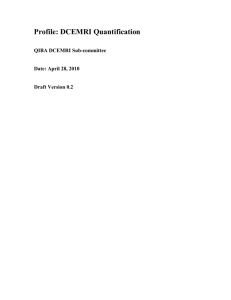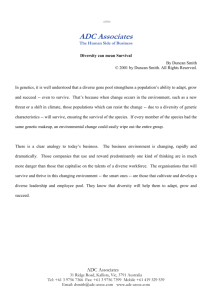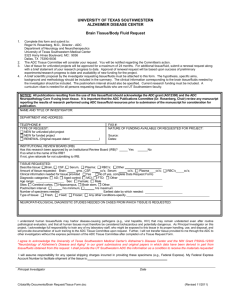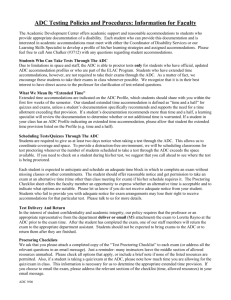MRI Image Quality Assessment
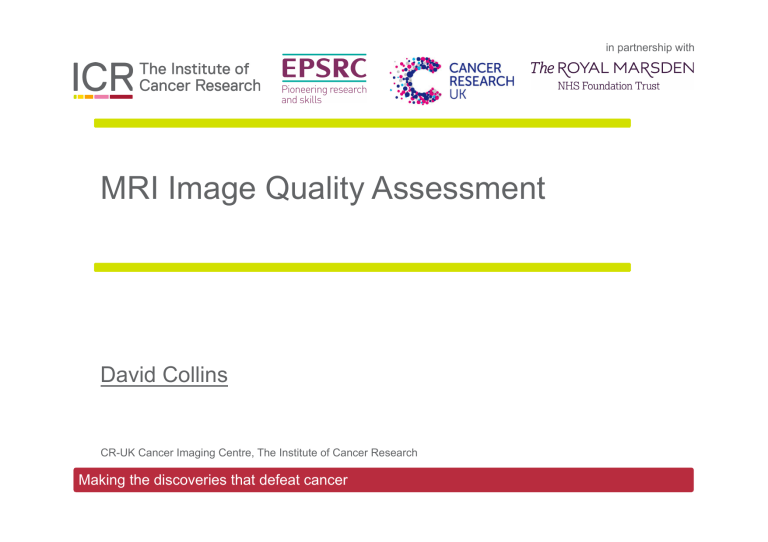
MRI Image Quality Assessment
David Collins
CR-UK Cancer Imaging Centre, The Institute of Cancer Research
Making the discoveries that defeat cancer in partnership with
Overview
• Current Practice
• Quality Assurance and Acceptance testing
• Emerging applications
• Quantitative DCE-MRI, DWI
• Whole Body
Acceptance Testing Current Practice
We measure 1, 2 :
Resonance Frequency
Signal to Noise
Spatial Linearity
Spatial Resolution
Slice Thickness
Slice Position/Separation
Image Uniformity
Artifacts; Phase and other ghosts
Many others
Dynamic and Quantitative Measurements, are the above sufficient?
1. Price et al Med Phys 17(2) Mar/Apr/ 1990 2. Och Med Phys 19(1) Jan/Feb 1992
Acceptance Testing Current Practice
We rarely measure as specified 1, 2 :
• Eddy Currents (sequence programming or integrator circuit
required)
• Slice Profiles (1D FT method)
• Nutation Angle calibration (vendor restrictions on user)
• SNR (Modern scanners have many Rx channels 72-128)
• B0 (Phase images not produced), spectroscopy not always an
option, vendors may provide field maps.
• B1 uniformity
1. Price et al Med Phys 17(2) Mar/Apr/ 1990 2. Och Med Phys 19(1) Jan/Feb 1992
Acceptance Testing Current Practice
We rarely measure as specified 1, 2 :
• Eddy Currents (sequence programming or integrator circuit
required)
• Slice Profiles (1D FT method)
• Nutation Angle calibration (vendor restrictions on user)
• SNR (Modern scanners have many Rx channels 72-128)
• B0 (Phase images not produced), spectroscopy not always an
option, vendors do provide field maps.
• B1 uniformity
We rely on vendor installation tests and procedures, it is now vitally important to engage a site physicist in this process
1. Price et al Med Phys 17(2) Mar/Apr/ 1990 2. Och Med Phys 19(1) Jan/Feb 1992
Acceptance Testing Current Practice
• How long should we spend performing acceptance testing?
• At the Royal Marsden/ICR we allocate one week.
• At least two senior clinical scientists with trainees.
• We use a range of vendor, Eurospin test objects and home built test objects.
• Some sites (DGH) perform zero testing.
Examples of gradient linearity correction
• Previously gradient linearity required extensive evaluation and correction if MR images were used for R/T planning 1
• Vendors now provide gradient linearity correction as either a default or selection option
1. Doran et al. Medical Physics 2005
Coronal
Orientation
Geometrical Distortions in Spin Echo
Sequences
NSA=1, Slice thickness=5mm NSA=2, Slice thickness=5mm
Sequence
5mm, 1NSA x y
5mm, 2NSA x y
3mm, 2NSA
3mm, 2NSA, without Dist Cor
3mm, 2NSA, with
Body Coil x y x x y y
NSA=2, Slice thickness=3mm NSA=2, Slice thickness=3mm,
Without Distortion Correction
% deviation
0.42
0.42
0.83
0.42
1.25
0.42
0.83
0
0.83
0
NSA=2, Slice thickness=3mm
With Body Coil
Custom-built Quality Assurance equipment 1 .
3T Achieva, without and with
3D distortion correction 2 .
Test object dimensions:
440mm LR, 400mm HF, 250mm AP
1.Tanner et al, Phys Med Biol 2000 Aug;45(8):2117-32 2.Doran et al. Medical Physics 2005
Gradient Linearity QA Test Object
Rapid 3D DCE-MRI protocol coronal acquisition
No Gradient Correction Vendor Gradient Correction
Dimensions 28 x 28cm Virtualscopics test object
Gradient Linearity QA Test Object
Rapid 3D DCE-MRI protocol coronal acquisition
No Gradient Correction Vendor Gradient
Correction
Dimensions 28 x 28cm Virtualscopics test object
SNR
• Well established tests for conventional Spin Echo.
• In practice single spin echo rarely used except acceptance testing
• Parallel imaging is now ubiquitous in clinical protocols.
• How do we assess SNR is a protocol specific way?
• Is it a practical measure with multiple channels and flexible coils?
Evaluation of SNR with G-noise
Sum of Squares Adaptive Combine
Mean 826 Mean 894
2D EPI, parallel imaging factor 2, different signal combination options
All other measurement parameters fixed.
Evaluation of G-noise
Sum of Squares Adaptive Combine
Mean 22.278 Mean 6.187 snr = 36.25 snr =144.49
Note the spatial dependence of the noise distribution
Images acquired off resonance, alternatively transmitter at 0v.
Changing Role of MRI
• Moving from purely morphological to include functional quantitative imaging
• Moving from regional to whole body or large field of view imaging
32 Receiver channels
72 CP receiver elements in this configuration.
Functional Measures
Functional MRI (fMRI)
• 1-10+ minutes
Dynamic susceptibility contrast (DSC-MRI)
• 1-2 minutes
Dynamic Contrast Enhanced (DCE-MRI)
• 4-8 minutes
Diffusion Weighted Imaging (DWI)
• 1-30 minutes
Functional Measures
Functional MRI (fMRI)
• 1-10+ minutes
Dynamic susceptibility contrast (DSC-MRI)
• 1-2 minutes
Dynamic Contrast Enhanced (DCE-MRI)
• 4-8 minutes
Diffusion Weighted Imaging (DWI)
• 1-30 minutes
3 of the above typically use Echo Planar Imaging readout
Requirements for Functional
Measures
• Temporal stability
• Rapid data acquisition, high parallel imaging factors
• Eddy Current compensation
• Uniformity of both B0 and B1 +
DCE-MRI Protocol Schematic
MR images using different
T1 contrast
Dynamic Series
Contrast agent injection
Measurement of T
1
pre-injection Measurement of T
1
post-injection
Schematic diagram of the data acquisition
Quality Control for DCE-MRI
Acquisitions
Dynamic contrast enhanced imaging requires an accurate and precise measurement of T1 changes to model pharmacokinetic behaviour.
T1 measurements can be affected by many factors including
• Slice profile
• Scanner stability (RF and gradients)
• B1 variations
• K-space sampling
Evaluate how these factors can effect T1 measurements with a series of phantom experiments at 1.5T and 3.0T.
Phantoms
What should be assessed
•
•
•
•
•
•
∆ Signal(t)
⇒
∆ T1(t)
⇒
∆ [Gd](t) in true “dynamic” phantom that emulates tissue enhancement and is well characterized? … extremely difficult!
Range of T1 / T2 values of well characterized materials in “static” phantom. … feasible!
Spatial uniformity of transmit (B1) field
System SNR under test and clinical DCE scan conditions
CNR under DCE scan conditions
Repeatability and reproducibility
T1 Measurement Accuracy
Phased array coil
Sequence parameters of T1 measurement methods
• Inversion recovery turbo-FLASH method
• TR/TE/ θ /NSA = 10 000 ms/1.14 ms/2°/1
• 39 inversion times varying from 112 – 9000 ms
• Variable flip angle method
• 3D GRE sequence
• TR/TE/NSA = 4.36 ms/1.36 ms/3
• 3 varying θ s = 2°, 8° and 12°
• Measurements were acquired with GRAPPA (iPAT = 2) and without GRAPPA
Siemens, Avanto (1.5T)
A quick, easy and accurate method of T1 measurement is the variable flip angle (VFA) method 1 where gradient echo MR images are acquired using different flip angles,
α i and T1 is calculated from the gradient of the linear plot of Si/sin( α i) vs. Si/tan( α i)
A range of [Gd] doped water phantoms with T1 values ranging from 55ms-2865ms were evaluated .
No major difference in T1 values obtained with and without partial parallel imaging
1. Fram et al Magn Reson Imaging. 1987;5(3):201-8.
Accuracy of Variable Flip Angle Method at 1.5T
T1 Map (200-1300)ms )
The accuracy and dynamic stability of clinical
DCE-MRI protocols are assessed with phantom measurements
Eurospin test object
• Eurospin TO5 with 12 gels (T1’s ranging from 200 to 1300ms) were measured.
• In each experiment the phantom temperature was equilibrated and recorded.
• Dynamic stability was evaluated
GRE sequences frequently exhibited an initial (40 second to 2 minutes) signal drift in T1W acquisitions.
The signal drift in T1W images translates to 8-12% change in calculated T1 values
Stability of DCE-MRI measurements
Dynamic acquisitions may have a 2% T1 variation over the initial 10-20 seconds.
Calculated T1 values across a dynamic time series had different dynamic variability depending on the sampling scheme used.
Standard deviations ranged from 11.5ms
(elliptical encoding) to 4.7ms (elliptical encoding with phase and slice undersampling).
1.5T
No signal drift has been observed at 3T and dynamic variation is comparable with experiments at 1.5T.
The standard deviation of 3D GRE sequences was reduced from 12.4ms to
6.4ms with the use of phase stabilisation.
Eurospin test object is temperature sensitive ~3% change in T1 with 1 o C (20-23 o C)
3.0T
GRE Slice profiles
2° 5°
Slice profiles obtained from measurements at different nutation angles using a silicone oil test object.
12° 18°
Slice profile results can be used to provide correction terms within the post-processing software to correct these errors.
Essential to ensure that the slice positioning is centred on the region of interest.
Brookes JA et al; J Magn Reson Imaging. 1999 Feb;9(2):163-71.
8°
24°
Sample T1 = 740ms
Inhomogeneous Transmit RF (B
1
) Field
RF transmit coils produce non-uniform field strengths
FAs vary over the field of view
% dT
1 vs. T
1
40% error in α
30% error in α
20% error in α dT
1
≈ 2 × d α
10% error in α
T
1
(ms)
B
1
∞ θ Correct δ T1 by performing in-vivo B
1
mapping
Sung et al Magn Reson Med. 2013 Oct;70(4):954-61
B1 Correction @3.0T
1
Typical value for breast at 3.0T
ROI
Fatty tissue ROI
T1 = 77ms
.
Original T1 estimate nutation angles 3 o and 16 o
1. Linderman et al JMRI (40); 171-80 2014 Data courtesy of Elizabeth O’Flynn
DCE-MRI QA Assessments
• Noise Factor evaluated from full
DCE-MRI protocol
• Useful for comparing protocols
• Can be applied to pre-enhanced clinical data
• SNR evaluated from full DCE-
MRI protocol
• Useful for comparing protocols
• Useful for routine QA
Kurland RJ MRM 2;136-158 1985 Imran J et al MRI 17;1347-1356 1999
What is diffusion MR?
Signal is exponentially dependent on the ADC and the sequence parameters (b-value):
b = 0 s mm -2 b = 50 s mm -2 b = 100 s mm -2 b = 250 s mm -2 b = 500 s mm -2 b = 750 s mm -2
ADC map
Diffusion Weighted Imaging Quality
Assurance
• Use a range of phantoms:
• ADC accuracy use Sucrose, PVP (temperature sensitive)
• Ice water, temperature insensitive (long preparation >60mins)
• Silicone oil, non diffusing material (artefact assessments)
• Flood phantom ADC linearity
• Fat/Water test object (evaluate fat suppression efficiency)
• Others; alkanes for ADC, standard geometrical test objects
Diffusion Encoding pulse schemes
Unipolar Diffusion encoding scheme
Stejskal-Tanner
Scanning with shorter TE
Bipolar Diffusion encoding scheme
Reduction of eddy currents induced spatial distortions 1
1. Chan et al J Magn Reson. 2014 Jul;244:74-84
EPI N/2 Ghosting
Axial images of a PDMS phantom acquired using receive bandwidths (a) 1628
Hx/pixel, (b) 1776 Hx/pixel, (c) 1860 Hx/pixel, (d) 2170 Hx/pixel, (e) 2298 Hx/ pixel, (f) 2442 Hx/pixel, (g) 2790 Hx/pixel, (h) 3004 Hx/pixel b = 0 s mm -2 ).
Images have been windowed to enhance the visibility of the ghosts, at the same window width and level.
Target to reduce ghosting below 3%
EPI N/2 Ghosting
Axial images of a PDMS phantom acquired using receive bandwidths (a) 1628
Hx/pixel, (b) 1776 Hx/pixel, (c) 1860 Hx/pixel, (d) 2170 Hx/pixel, (e) 2298 Hx/ pixel, (f) 2442 Hx/pixel, (g) 2790 Hx/pixel, (h) 3004 Hx/pixel b = 0 s mm -2 ).
Images have been windowed to enhance the visibility of the ghosts, at the same window width and level.
What bandwidth should we use for N/2 ghost assessment ?
Optimization of protocol critical to success
Eddy currents: image distortion
b0 b0 – b1000
: b0
(background)
754 Hz/px 1450 Hz/px 2012 Hz/px 2416 Hz/px
Optimization of protocol critical to success
Eddy currents: image distortion
b0 b0 – b1000
: b0
(background)
754 Hz/px 1450 Hz/px 2012 Hz/px 2416 Hz/px
(a) monopolar
Axial images of a PDMS phantom
(a, b) b = 0 s mm -2 , (c, d) b = 1000 s mm -2 and (e, f) subtraction images. Images (a, c) acquired using a monopolar sequence and (b, d) using DSE
Subtraction images show the b = 0 s mm -2 image subtracted from the b = 1000 s mm -2 image.
(c)
(b) DSE
(d)
(e) (f)
8000
6000
4000
2000
0
5000
8000
6000
4000
2000
0
0
ï 5000
Quality Assurance ADC Accuracy
ADC water @0 o C = 1.1
× 10 − 3 mm 2 /s
Malyarenko D et al J Magn Reson Imaging. 2013 May;37(5):1238-46
Polyvinylpyrrolidone (PVP) phantom
The cylindrical ice –water phantom was used for the experiment, containing the vials with the different PVP concentrations.
#
ROI 1
ROI 2
ROI 3
ROI 4
ROI 5
ROI 6
ROI 7
PVP (% w/w)
0
2.5
5
10
15
20
25
45 min before the scanning the phantom was refilled with ice-water, in order to obtain a temperature of 0 0 C.
Dr Marianthi-Vasiliki Papoutsaki
ADC estimates from PVP phantom 1
PVP
(% w/w)
0 - ROI1
2.5 – ROI2
5 - ROI3
10 – ROI4
15 – ROI5
20 – ROI6
25 – ROI7
ADC median
(*10 -3 mm 2 /s)
1.12
1.05
0.99
0.85
0.71
0.60
0.50 ADC map
Linear relationship between PVP
R 2 = 0.996
0
0 C
Boss et al ISMRM 2013 Dr. Marianthi-Vasiliki Papoutsaki
ADC
ADC Uniformity Assessment
ADC profile
Evaluation of ADC uniformity is essential for quantitative WBDWI
Malyarenko et al. Magn Reson Med. 2013 May 13. Courtesy Dr. Jessica Winfield
ADC profile
Gradient
~2%
ADC profile
Non -Uniform
ADC ADC
ADC uniformity is image acquisition, reconstruction and post-processing dependent
Courtesy Dr. Jessica Winfield
ADC profiles along x and z axis of bipolar and unipolar diffusion pulse xaxis
Median ADC value +/-
2.5%
Centred at isocentre
ADC map bipolar zaxis
Median ADC value +/-
2.5%
Centred at isocentre
53% deviation from the median value in bipolar
Dr Marianthi-Vasiliki Papoutsaki
Fat-Water Test-object
Inner cylinder: water/NaCl/CuSO
4
Annulus:
Corn oil coronal
400 mm x 400 mm FOV
Gradient echo localiser images. Test object placed at
45 degrees to z-axis to create large ellipse in axial slices.
185 mm
140 mm axial
400 mm x 400 mm FOV
Winfield et al Phys Med Biol. 2014 May 7;59(9):2235-48
Upfield and downfield fat signals
Test object:
No fat suppression, b=900
Volunteer:
No fat suppression, b=900
• upfield fat (1.3 ppm) shifted in anterior direction
• downfield fat (5.3 ppm) shifted in posterior direction
Courtesy Dr. Jessica Winfield
Unsuppressed upfield fat at edges of
FOV using SPAIR at 1.5 T
Test object:
SPAIR, b=900
Volunteer:
SPAIR, b=900
• Unsuppressed upfield fat at edges of FOV in test object and volunteer
• SPAIR leaves downfield fat signal unsuppressed
Courtesy Dr Jessica Winfield
Whole Body Dixon (Fat/Water)
• Whole Body Dixon registered and fused with WBDWI a) WBDWI, b) Water, c) Fused a)+b), d) Dixon T1 map, e) Water ratio
Whole Body Dixon (Fat/Water)
• Whole Body Dual Contrast Dixon registered and fused with WBDWI a) WBDWI, b) Water, c) Fused a)+b), d) Dixon T1 map, e) Water ratio
Three quantitative whole body metrics ADC, T1 and Fat/Water ratio
Blackledge et al ISMRM 2009
Semi-automatic segmentation
+ b = 0 s/mm 2 ADC map
Acquired data
Select computed b-value and initial disease threshold
Smoothing of regions using
Markov random field model
(MRF)
Visualization/quantification of disease
User modifiable regions of interest
(ROI)
Blackledge et al PLoS One. 2014 Apr 7;9(4):e91779.
ADC stats
(x10 -3 mm 2 /s)
Mean
Variance
Skewness
Kurtosis
Pretreatment
0.88
0.05
0.46
1.00
Posttreatment
1.15
0.15
-0.02
-1.15
Discussion
• Routine Acceptance testing and QA informs only on the important basic functionality
• Broader range of test objects required
• How well do phantom measurements translate into meaningful measures (eg ADC repeatabilty, DCE-MRI noise factors)?
• QA has to move from the generic to the assessment of specific clinical protocols
Acknowledgements
Dr James d’Arcy
Dr Jessica Winfield
Dr Mihaela Rata
Dr Marianthi-Vasiliki Papoutsaki
Dr Matthew Blackledge in partnership with


